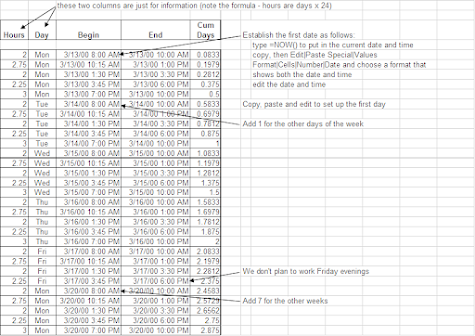Manufacturing Corner on
Saturday, November 26, 2022
So far we have scheduled using hours, rather than days, to measure short periods of time. Somehow "I have a meeting with a client, it should take about 2 hours" sounds better than "it should take about 0.08333 of a day". We have also pegged "zero hour" at midnight on some arbitrary day, rather than midnight 1 January 1900. But we will need to get used to these ideas if we are going to harness the full power of Julian dates.
Here is a calendar using Julian dates:
A calendar for a live scheduling system may be up to several thousand rows long, so you may wish to replace the formulas with values, after you have set it up,
to save on memory and calculation time. You can allow for public holidays by deleting rows,
and you can allow for overtime by inserting rows or by extending the working periods.
After deleting or inserting rows, don't forget to copy down the formula in the Cum Days column.
A quick way of copying a formula down to the bottom of the block of data, is to select the top cell, then point to the bottom .
right corner of the cell, and when the solid black cross appears, like this:


0 Komentar untuk "Section 8 - Setting up a Julian Calendar"